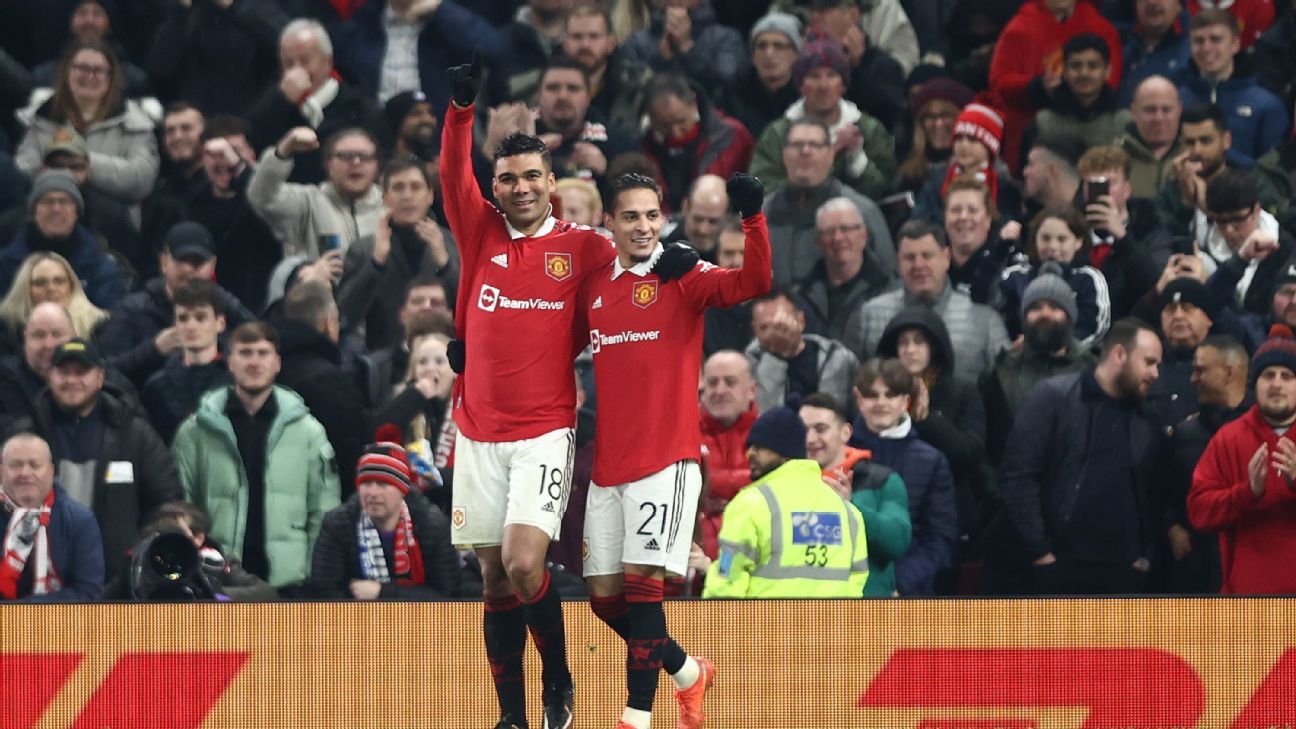When it comes to sports, this is the circle of life. The biggest clubs spend big on other teams’ burgeoning stars so they can win trophies, or at least signal to their fans that they’re trying to. Others make a living off of those transfer fees, happily sending their stars to said clubs so they can procure their next round of stars (and eventually send those guys away too).
– Stream on ESPN+: LaLiga, Bundesliga, more (U.S.)
Of course, big transfer spending doesn’t correlate as well to success as it perhaps should — over the past year, we’ve seen some crystal clear examples of how inefficient this market remains — but whatever your strategy, if you nail a given set of windows, it can transform your club. Just ask Napoli and Chelsea.
Napoli brought in more money from transfer fees than they spent last summer and, in effect, used the proceeds from the exit of veteran defender Kalidou Koulibaly to Chelsea (€38 million) to add what are now regarded as two of the best players in Europe — winger Khvicha Kvaratskhelia (€11.5m) and defender Kim Min-jae (€18.1m). That helped transform them into a squad capable of running away with the Serie A title, which they did. Chelsea, meanwhile, became addicted to writing checks instead of actually building a team, spent more than €600m on talent acquisitions, and might end up with their worst Premier League finish in 29 years.
The 2022-23 season is almost in the books, and the engine of the next transfer season is revving up loudly in the background. Now is a good time to reflect. Who actually benefited from spending big? Who nailed a thriftier approach?
To look at this past year’s winners and losers, let’s break teams into four quadrants: two good and two bad. Among the teams in Europe’s Big Five leagues, who spent big (in terms of transfer fee balance) and who didn’t? Who actually got better and who didn’t?
Obviously, the transfer fee is only one of two numbers that matter — the other being the salaries that teams are paying — and not every move is made to pay off immediately. Plenty of clubs build for the future. But with the urgency and non-stop nature of the Transfer Industrial Complex, looking at immediate returns is relevant, especially considering how one great or terrible window can define your fortune for years to come.
(Note: All transfer figures come from Transfermarkt.)
Big spending, big improvement
 Newcastle United
Newcastle United
Spending: €185.4m
Biggest arrivals: FW Alexander Isak (Real Sociedad, €70m), MF Anthony Gordon (Everton, €45.6m), DF Sven Botman (Lille, €37m)
Income: €13.3m
Biggest exits: MF Jonjo Shelvey (Nottingham Forest, €6.5m)
Balance: -€172.1m
Change in performance: +0.59 points per game (to 1.89, third place)
Before adding Isak in late August, Newcastle’s spending had basically been that of the average Premier League team despite the general wealth of their new Saudi Arabia-backed owners. And even now, you can’t really say they have been outspending the field. Regardless, Isak and other newcomers such as Botman and goalkeeper Nick Pope have been key to Newcastle’s rise from 11th place in 2021-22 to Champions League qualification in 2022-23.
 Barcelona
Barcelona
Spending: €158m
Biggest arrivals: FW Raphinha (Leeds United, €58m), DF Jules Kounde (Sevilla, €50m), Robert Lewandowski (Bayern Munich, €45m)
Income: €39.5m
Biggest exits: MF Philippe Coutinho (Aston Villa, €20m), FW Pierre-Emerick Aubameyang (Chelsea, €12m)
Balance: -€118.5m
Change: +0.51 points per game (to 2.43, first place)
Pulling the various financial levers to raise funds amid their immense debt certainly didn’t help Barcelona avoid another dud in European competitions, but it made a massive difference domestically. In 2021-22, they recorded their lowest LaLiga points total in 18 years; in 2022-23, newcomers Lewandowski and Raphinha combined for 42 goals and assists, Kounde helped to completely transform the defense and Barca rolled to an easy league title.
 Manchester United
Manchester United
Spending: €243.3m
Biggest arrivals: FW Antony (Ajax, €95m), MF Casemiro (Real Madrid, €70m), DF Lisandro Martinez (Ajax, €57.4m)
Income: €13.3m
Biggest exits: MF Andreas Pereira (Fulham, €9.5m)
Balance: -€230.0m
Change: +0.39 points per game (to 1.92, fourth place)
The transfers themselves were a mixed bag this season — Casemiro was transformative and Martinez quickly became a defensive stalwart, only for Antony to deliver just four goals and two assists despite his huge transfer fee — but there’s no question that the team took a step forward this season under new manager Erik ten Hag. United have already topped last season’s point total by 11 and still have two matches left.
 Arsenal
Arsenal
Spending: €192.4m
Biggest arrivals: FW Gabriel Jesus (Man City, €53.2m), DF Oleksandr Zinchenko (Man City, €35m), MF Fabio Vieira (Porto, €35m)
Income: €23.8m
Biggest exits: MF Matteo Guendouzi (Marseille, €11m)
Balance: -€168.6m
Change: +0.37 points per game (to 2.19, second place)
Arsenal lured Jesus and Zinchenko from Manchester to London and, combined with further development from an exciting young roster core, it paid off. The Gunners still didn’t have enough juice to maintain a title push for nine full months, but after finishing 24 points behind Manchester City last season, they’ll likely finish only eight to 10 points behind this time around. They’ll also play in the Champions League next season for the first time since 2016-17.
 Marseille
Marseille
Spending: €115.4m
Biggest arrivals: FW Vitinha (Braga, €32m), GK Pau Lopez (Roma, €12m), MF Matteo Guendouzi (Arsenal, €11m)
Income: €37.5m
Biggest exits: MF Gerson (Flamengo, €15m), DF Duje Caleta-Car (Southampton, €8m)
Balance: -€77.9m
Change: +0.16 points per game (to 2.03, third place)
After last season’s second-place finish, Marseille tried, on a couple of occasions, to make the most of the newfound Champions League cash and close the gap on PSG. They’d already spent big before adding Vitinha in late January, and it has sort of paid off. After finishing with 71 points last season, they’re up to 73 with two games to play, but they’ve also fallen into third place behind a surging Lens
Big spending, big regression
 Chelsea
Chelsea
Spending: €611.5m
Biggest arrivals: MF Enzo Fernandez (Benfica, €121m), DF Wesley Fofana (Leicester City, €80.4m), DF/MF Mykhailo Mudryk (Shakhtar Donetsk, €70m), DF Marc Cucurella (Brighton, €65.3m), Raheem Sterling (Man City, €56.2m)
Income: €67.8m
Biggest exits: FW Timo Werner (RB Leipzig, €20m), DF Emerson (West Ham, €15.4m), MF Jorginho (Arsenal, €11.3m)
Balance: -€543.7m
Change: -0.76 points per game (to 1.19, 12th place)
One of Europe’s biggest collapses came from Europe’s biggest-spending team. Chelsea attempted win-now signings (Koulibaly, Sterling) in July and August, then win-later youth signings (Fernandez, Mudryk and many others) in January. Maybe they will indeed win later, but their 2022-23 campaign has been an absolute disaster.
The big spending has put them on the verge of potential financial fair play issues — something a lack of Champions League revenue could further complicate — but if recent transfer rumors turn out to be true, their solution to this season’s problems appears to be … more big spending. It could work out well for the teams depositing their big checks, anyway.
 West Ham
West Ham
Spending: €194m
Biggest arrivals: MF Lucas Paqueta (Lyon, €43m), FW Gianluca Scamacca (Sassuolo, €36m, DF Nayef Aguerd (Rennes, €35m)
Income: €21.6m
Biggest exits: DF Issa Diop (Fulham, €17.8m)
Balance: -€172.4m
Change: -0.40 points per game (to 1.08, 14th place)
It has turned out to be a pretty good bad season for the Hammers, who have reached the final of the Europa Conference League — a win would give them their first European trophy since the 1965 Cup Winners’ Cup — and have rallied to 14th place in the Premier League after flirting with relegation. That has distracted from the fact that, aside from perhaps Paqueta and Aguerd, most of the team’s newcomers have failed to make any significant impact in 2022-23 and, at best, West Ham will finish with 13 fewer points than they had last season.
 Southampton
Southampton
Spending: €143.7m
Biggest arrivals: FW Kamaldeen Sulemana (Rennes, €25m), FW Paul Onuachu (Genk, €18m), GK Gavin Bazunu (Man City, €14m), MF Carlos Alcaraz (Racing Club, €13.7m)
Income: €5.5m
Biggest exits: MF Oriol Romeu (Girona, €5.5m)
Balance: -€138.2m
Change: -0.41 points per game (to 0.65, last place)
After back-to-back 15th place finishes in the Premier League, one of the most successful developmental clubs in Europe attempted to solve their problems by signing players instead of letting them go in 2022-23. The result: a pair of increasingly desperate managerial changes and a last-place finish.
1:22
Michallik: Kane is the only one who delivers for Tottenham
Janusz Michallik reacts to Tottenham’s 1-0 home win vs. Crystal Palace where Harry Kane moves second in the all-time Premier League goalscoring charts after netting the only goal of the game.
 Tottenham
Tottenham
Spending: €177.9m
Biggest arrivals: FW Richarlison (Everton, €58m), DF Cristian Romero (Atalanta, €50m), MF Yves Bissouma (Brighton, €29.2m)
Income: €38.8m
Biggest exits: FW Steven Bergwijn (Ajax, €31.3m)
Balance: -€139.1m
Change: -0.33 points per game (to 1.54, eighth place)
Almost no team in Europe spends more time trying to look like a big, serious club instead of actually performing like one. That goes mostly for Spurs’ weird stylistic shifts in managerial hires, but it also applies to recent transfers.
Flush with Champions League cash after a couple of seasons away, Spurs spent a lot to sign six players (Destiny Udogie and Djed Spence went out on loan) and only one of them (Romero) topped 1,000 league minutes in 2022-23.
 Bayern Munich
Bayern Munich
Spending: €145.5m
Biggest arrivals: DF Matthijs de Ligt (Juventus, €67m), FW Sadio Mane (Liverpool, €32m), FW Mathys Tel (Rennes, €20m)
Income: €104.1m
Biggest exits: FW Robert Lewandowski (Barcelona, €45m), DF Tanguy Nianzou (Sevilla, €16m)
Balance: -€41.4m
Change: -0.20 points per game (to 2.06, second place)
Technically, Liverpool — yet another big-spending Premier League team — should probably fit here, since they had both a larger negative balance and worse per-game regression. But for variety’s sake, we’ll briefly leave England to include the German giants, who are on the verge of finishing second in the Bundesliga for the first time in 11 years.
Their attack is still good, but replacing Lewandowski (35 league goals and three assists last season) with Mane and Tel (combined: 12 and 5 this season) has not immediately paid off.
Thrifty spending, big Improvement
First, a quick acknowledgment of the work of Manchester City. They are no one’s idea of a “thrifty club,” but thanks to moves like Arsenal’s (for Jesus and Zinchenko) and Chelsea’s (for Sterling), they actually ended up with a net profit in transfer fees, bringing in €162.2m and sending out €150.5m, while adding Erling Haaland (€60m) and Julian Alvarez (€21m), among others. They don’t make the “big improvement” list because they were already the best team in Europe, but that’s obviously pretty good business.
Now to the improved teams.
2:36
Marcotti: Napoli’s title-winning season a tremendous achievement
Gab Marcotti credits Napoli’s front office for putting the team in position and acquiring the necessary pieces to win their first title in 33 years.
 Napoli
Napoli
Spending: €76.1m
Biggest arrivals: DF Kim Min-jae (Fenerbahce, €18.1m), DF Mathias Olivera (Getafe, €16.5m), MF Frank Anguissa (Fulham, €16m), MF Khvicha Kvaratskhelia (Dinamo Batumi, €11.5m)
Income: €80.5m
Biggest exits: DF Kalidou Koulibaly (Chelsea, €38m), MF Fabian Ruiz (PSG, €23m), FW Arkadiusz Milik (Marseille, €8m)
Balance: +€4.4m
Change: +0.31 points per game (to 2.39, first place)
In Kim, Olivera, Anguissa and Kvaratskhelia, the club added four players who have combined for 9,794 minutes — plus 19 goals and 19 assists — for the best and most successful Napoli team in a generation. All for less money than Chelsea paid to sign Marc Cucurella (€65.3m.)
 Brighton
Brighton
Spending: €55.7m
Biggest arrivals: DF Pervis Estupinan (Villarreal, €17.8m), FW Julio Enciso (Libertad, €11.6m)
Income: €137.9m
Biggest exits: DF Marc Cucurella (Chelsea, €65.3m), MF Yves Bissouma (Tottenham Hotspur, €28.2m), FW Leandro Trossard (Arsenal, €24m)
Balance: +€82.2m
Change: +0.35 points per game (to 1.69, sixth place)
Among the Premier League’s 20 teams, Brighton generated the second-highest income total from transfer fees (only Man City, of all teams, generated more) and spent the fourth-lowest amount, ahead of only Brentford (€51.5m), Leicester City (€48m) and Crystal Palace (€46.6m.) Their transfer balance was by far the biggest in the league; while everyone around them was bringing in player, they were moving them on.
Now they’re set to play in Europe next season for the first time ever. Aside from Napoli, no one aced the transfer market more than the Seagulls. And their reward will be more transfers and the need to keep on acing the market.
 Lille
Lille
Spending: €26m
Biggest arrivals: FW Mohamed Bayo (Clermont, €14m)
Income: €101.5m
Biggest exits: DF Sven Botman (Newcastle, €37m), MF Amadou Onana (Everton, €35m), MF Renato Sanches (Paris Saint-Germain, €15m)
Balance: +€75.5m
Change: +0.30 points per game (to 1.75, fifth place)
After winning Ligue 1 in 2021, Lille lost manager Christophe Galtier and a number of key contributors. They stumbled to 10th in the league, then lost even more key players and began 2022-23 with just 13 points in their first nine games, basically the same per-game pace as last season.
Since early-October, however, they’ve had the third-best record in the league. Manager Paulo Fonseca handed the reins to a young core and has been rewarded for it. (Of course, that young core will likely get picked apart soon, too.)
 Lens
Lens
Spending: €38.4m
Biggest arrivals: FW Lois Openda (Club Brugge, €9.8m), FW Adam Buksa (New England Revolution, €6m)
Income: €51.6m
Biggest exits: MF Cheick Doucoure (Crystal Palace, €22.6m), DF Christopher Wooh (Rennes, €9m)
Balance: +€13.2m
Change: +0.54 points per game (to 2.17, second place)
Ligue 1’s most exciting story of 2022-23. Lens haven’t finished in Ligue 1’s top four since 2006 and only recently emerged from the second division. But after losing Doucoure and others from last season’s seventh-place squad, Les Sang et Or made one of the season’s most inspired additions (Openda) and lost only one of their first 20 league matches. They have all but clinched second in the league.
 Real Sociedad
Real Sociedad
Spending: €53m
Biggest arrivals: FW Umar Sadiq (Almeria, €20m), MF Brais Mendez (Celta Vigo, €14m)
Income: €80.5m
Biggest exits: FW Alexander Isak (Newcastle, €70m)
Balance: +€27.5m
Change: +0.23 points per game (to 1.86, fourth place)
La Real enjoyed back-to-back top-six finishes in 2021 and 2022 but hadn’t been able to end a nearly 10-year Champions League absence. And it didn’t seem this would be the year when they lost Isak in late-August. But a pair of astute deals — adding Real Madrid’s Takefusa Kubo (eight league goals and four assists this season) for just €6.5m, then bringing in RB Leipzig’s Alexander Sorloth (11 and two, respectively) on loan — helped to bring more juice to their attack. And now they’ve all but locked up a fourth-place finish.
Thrifty spending, big regression
 Angers SCO
Angers SCO
Spending: €6m
Biggest arrivals: DF Ousmane Camara (Paris FC, €2.2m), DF Cedric Hountondji (Clermont, €2m)
Income: €37m
Biggest exits: FW Momo Cho (Real Sociedad, €11m), MF Azzedine Ounahi (Marseille, €8m)
Balance: +€31m
Change: -0.66 points per game (to 0.42, last place)
Angers have managed to remain in the French top division since 2015, but that run is coming to an end after a dire 2022-23 campaign. And it gets even worse: While they didn’t bring in nearly enough talent of late, one of the players they did bring in, Ilyes Chetti, earned them a two-window transfer ban.
 Leicester City
Leicester City
Spending: €48m
Biggest arrivals: DF Wout Faes (Reims, €17m), DF Harry Souttar (Stoke City, €17m)
Income: €81m
Biggest exits: DF Wesley Fofana (Chelsea, €80.4m)
Balance: +€33.4m
Change: -0.53 points per game (to 0.84, 19th place)
For years, Leicester pulled off a nice balance, losing star players to big teams — Riyad Mahrez in 2019, Harry Maguire in 2020, Ben Chilwell in 2021 — but keeping others in tow and making a series of strong signings. But that fortune appears to have worn out. The roster grew stale, the club kept players like Youri Tielemens for too long, and the Foxes will need some good fortune on the Premier League’s final matchday to avoid relegation.
 Sevilla
Sevilla
Spending: €29.4m
Biggest arrivals: DF Tanguy Nianzou (Bayern Munich, €16m), DF Marcao (Galatasaray, €12m)
Income: €91.5m
Biggest exits: DF Jules Kounde (Barcelona, €50m), DF Diego Carlos (Aston Villa, €31m)
Balance: +€62.1m
Change: -0.47 points per game (to 1.37, ninth place)
As with West Ham, this has turned out to be a pretty good terrible season. Sevilla have once again reached the Europa League final (their fifth in 10 years), and after a dreadful start — they were one point outside of the relegation zone as late as March — they have charged back to ninth under recent hire Jose Luis Mendilibar. But things were dire for a bit, and exits like Kounde and Carlos did little to help.
 Sampdoria
Sampdoria
Spending: €6m
Biggest arrivals: FW Francesco Caputo (Sassuolo, €3.5m)
Income: €35.6m
Biggest exits: MF Mikkel Damsgaard (Brentford, €15m), FW Gianluca Caprari (Hellas Verona, €5m), FW Federico Bonazzoli (Salernitana, €5m)
Balance: +€29.6m
Change: -0.44 points per game (to 0.50, last place)
Financial problems overwhelmed Sampdoria this season, and that was reflected in a shell of a squad that featured only five of the primary 14 players from their ninth-place finish in 2020-21. Barring a quick change in ownership, their issues might follow them to second division next year, too.
 Bayer Leverkusen
Bayer Leverkusen
Spending: €15.1m
Biggest arrivals: FW Adam Hlozek (Sparta Prague, €13m)
Income: €9.5m
Biggest exits: FW Lucas Alario (Eintracht Frankfurt, €6m)
Balance: -€5.6m
Change: -0.36 points per game (to 1.52, sixth place)
Bayer Leverkusen kept the band together… and it didn’t work. After jumping to third place in the Bundesliga in 2021-22, the club warded off potential suitors to maintain an exciting, young roster core — attackers Moussa Diaby, Florian Wirtz and Patrik Schick, wing-backs Jeremie Frimpong and Mitchell Bakker, etc. But they won only two of their first 12 league matches, plus three of their first four Champions League matches, and fired manager Gerardo Seoane in October.
Xabi Alonso has been able to engineer a new-year rebound, but their dreadful start means they will miss next year’s Champions League.
